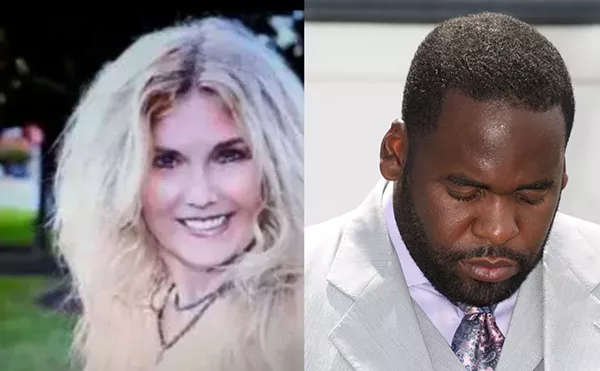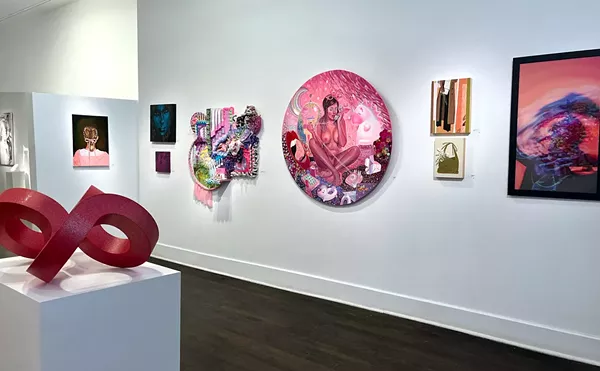
Audio By Carbonatix
[
{
"name": "GPT - Leaderboard - Inline - Content",
"component": "35519556",
"insertPoint": "5th",
"startingPoint": "3",
"requiredCountToDisplay": "3",
"maxInsertions": 100,
"adList": [
{
"adPreset": "LeaderboardInline"
}
]
}
]
In about 30 minutes, Yale art history professor Robert Farris Thompson wrecks practically every conventional wisdom about the Latin dance of love, the tango. For starters, it wasn’t always a dance between two people. Also, the best male dancers learn their moves with other men. And it may have taken off in Argentina, but it’s a gift from the Congo.
He says Arnold Schwarzenegger does a fantastic version of the dance in True Lies, offering his huge thigh “like an elephant offering an antelope a place to sit.” However, cinematic romancer Rundolph Valentino dances as stiffly as a mannequin, and you can just forget about Brando. “Last Tango in Paris was one of the worst movies to make fun of the step.”
And what’s this business about brothels? Was the tango ever a dance between a prostitute and a pimp? Watch your step, or Thompson loses it. “My God! That is the enemy of the tango! People say the same thing about jazz — that it began in the whorehouses. It grew up everywhere! That idea is so lame it makes me sick!” It’s pretty easy to get the professor all fired up.
Teaching at Yale University since 1961, Thompson, known to his students as “Master T,” is professor of African and African-American art, master of Yale’s Timothy Dwight College and author of several groundbreaking books, including Flash of the Spirit: African & Afro-American Art & Philosophy. He’s a self-described “guerrilla scholar,” a leader in analyzing the subtleties and continuities of African culture on both sides of the Atlantic. He’s “Yale’s Professor ‘Mambo,’” as a Chicago Tribune headline pegged him 20 years ago.
Thompson just finished Tango: The Art History of Love, a manuscript nine years in the making. This will be the basis of his lecture on Friday, March 18, at the University of Michigan’s three-day conference, “Rhythms of the Atlantic World: Rituals and Remembrances.”
The professor has been going to Buenos Aires since 1995. When he talks about the tango, you can tell how easily he finds his flow. His sentences start to rattle with sound effects, accompanied by snaps, claps and foot taps. He can’t help it. As blues composer W.C. Handy said when African rhythm hit a black crowd in New Orleans: The call of the blood spoke to them.
The tango matured in Buenos Aires, Argentina, in the 1870s, but it is a result of a cosmopolitan city, “a bouillabaisse” of cultures including Moors, Spaniards, Italians and Congolese. So Thompson says music in the late 19th century was a jazzy collision of African drum rhythms, flamenco finger-popping and stamping, Italian singing and possibly even something Eastern European, perhaps Russian Jewish, like the hora. “When the smoke cleared, it was tango.” The professor’s version of the dance’s evolution is a whirlwind of activity with nuanced historical details too numerous to mention, like a Spanish composer who went to Cuba and the French composer who heard his music. He points out that the beat of the tango is the beat all Americans recognize, but do we know it is also in Georges Bizet’s 1850 opera Carmen? “It’s called the habanera — that ‘choom cha-choom choom choom’ that most orchestras played in classical music.”
The dance of love that we know is illegitimate. The real tango is not sleazy grinding. It’s subtle and cool, a fusion of African solo steps and the couple’s embrace in European dancing. It’s about control and every expression is lighting fast; it’s a kick between the legs or a bump on the hip. This is the art of it, a way for a man and woman to show they are attracted to each other but know how to channel the attraction. “You see, every sexy look is just a taste — boom! choom!”
If the tango is all about love, how could it possibly have begun as a solo show? “You can show love even though you dance apart. You dance in relation to the other … if you like her, she looks up, so you saddle up and bump her once.” That momentary flash of togetherness, when dancers strike bellies together, is called an umbigada. Thompson calls it real romance. “It’s a tease that says, ‘You belong to me, baby.’”
He believes Buenos Aires is where the music scene is at:
“In the U.S., you go into dance clubs and ‘thump thump thump’ is all they play, but go into a milonga [an Argentinean dance hall], you’ll hear tango, waltz, jazz, good ol’ swing … anything we’ve ever done ... but they’re more sophisticated than we are. Everyone hangs out together, young and old. People in their 50s and 60s can go hang out and have a good time with kids in their 20s. Nobody says ‘eek’ when they’re with their parents.” Thompson, who’s been dancing the tango for years, says the city is all about music and rhythm, and its soul “is bubbling over with blackness. The best dancers? They’re black. The best B-Boys? Them too.”
Dr. Thompson simply won’t rest until he has you believing what he knows to be the truth: At its heart, tango is a dance formed on the dark side.
At 12:30-2 p.m. on Friday, March 18, in the Hussey Room (second floor) at the Michigan League (911 N. University Dr., Ann Arbor; 734-764-0446) or see the online version of this story for a link to more information about “Rhythms of the Atlantic World: Rituals and Remembrances” onference, March 16-18.
Other event highlights include “Performing Haiti,” a lecture by CUNY professor Millery Polyné about the effects of tourism on traditional dance, and a performance by and conversation with Detroit’s Papa Hanne Senegalese/African-American Dance Company; 1:45-3:45 and 4-5 p.m. respectively on Thursday, March 17, also in the Hussey Room. The conference is free and open to the public.
In an unrelated tango event, the Phoenix Ensemble performs the “nuevo tango” of composer Astor Piazzolla, March 18-19, at Kerrytown Concert House, 415 N. Fourth Ave., Ann Arbor; 734-769-2999.
Rebecca Mazzei is Metro Times arts editor. Send comments to rmazzei@metrotimes.com




